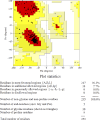LC-MS profiling and cytotoxic activity of Angiopteris helferiana against HepG2 cell line: Molecular insight to investigate anticancer agent
- PMID: 39739862
- PMCID: PMC11687663
- DOI: 10.1371/journal.pone.0309797
LC-MS profiling and cytotoxic activity of Angiopteris helferiana against HepG2 cell line: Molecular insight to investigate anticancer agent
Abstract
Liver cancer is one of the most prevalent malignant diseases in humans and the second leading cause of cancer-related mortality globally. Angiopteris helferiana was mentioned as a possible anticancer herb according to ethnomedicinal applications. However, the molecular docking and chemical profiling of the bioactive phytoconstituents accountable for the reported anticancer action still require research. The present study aims the phytochemical profiling and bioactivity evaluation of A. helferiana. The study design with in-vitro and in-silico technique of the LC-MS followed by a study of the ligand-protein interaction using the molecular docking method, and investigates the cytotoxic activity by MTT assay of A. helferiana bioactive compounds on HepG2 cell lines. LC-MS results detected seventeen phytoconstituents in A. helferiana extract belonging to variable chemical classes with most prevailing compounds such as Vicenin 1, Schafroside, Violanthin, Coumarin, Quercetin, Angiopterioside, and Corosolic acid. The finding concluded that Quercetin showed significant binding energy of -8.8 kcal/mol and then Schafroside also possesses the binding energy of -8.1 kcal/mol against the human PPAR-δ receptor (PDBID: 1I7G). The extract showed the moderate cytotoxic activity having IC50 value of 236.93 μg/mL. Our finding suggests that these bioactive compounds could be developed as promising anticancer agent, but further in-vivo study require to validate the finding along with isolation of individual phytoconstituents.
Copyright: © 2024 Pandey et al. This is an open access article distributed under the terms of the Creative Commons Attribution License, which permits unrestricted use, distribution, and reproduction in any medium, provided the original author and source are credited.
Conflict of interest statement
The authors have declared that no competing interests exist.
Figures










Similar articles
-
UHPLC-QTOF-MS-Based Metabolic Profiling, Estimation of Antioxidants and Anticancer Potential Assessment of Dicliptera bupleuroides Nees by Caspase Activation, and ROS and MMP Evaluation by Using Fluorescence Microscopy.Microsc Res Tech. 2025 Jun;88(6):1748-1764. doi: 10.1002/jemt.24811. Epub 2025 Feb 5. Microsc Res Tech. 2025. PMID: 39908284
-
Novel Anti-Tubulin Compounds from Trigonella foenum-graecum Seeds; Insights into In-vitro and Molecular Docking Studies.Drug Des Devel Ther. 2021 Oct 5;15:4195-4211. doi: 10.2147/DDDT.S320793. eCollection 2021. Drug Des Devel Ther. 2021. PMID: 34675483 Free PMC article.
-
Phytochemical Profiling, In Vitro and In Silico Anti-Microbial and Anti-Cancer Activity Evaluations and Staph GyraseB and h-TOP-IIβ Receptor-Docking Studies of Major Constituents of Zygophyllum coccineum L. Aqueous-Ethanolic Extract and Its Subsequent Fractions: An Approach to Validate Traditional Phytomedicinal Knowledge.Molecules. 2021 Jan 22;26(3):577. doi: 10.3390/molecules26030577. Molecules. 2021. PMID: 33499325 Free PMC article.
-
In-vitro Antioxidant, In-vitro and In-silico Ovarian Anticancer Activity (Ovarian Cancer Cells-PA1) and Phytochemical Analysis of Cissus quadrangularis L. Ethanolic Extract.Comb Chem High Throughput Screen. 2024;27(10):1504-1512. doi: 10.2174/0113862073255558230926114444. Comb Chem High Throughput Screen. 2024. PMID: 37818574
-
Chemical Characterization, In-silico Evaluation, and Molecular Docking Analysis of Antiproliferative Compounds Isolated from the Bark of Anthocephalus cadamba Miq.Anticancer Agents Med Chem. 2022;22(20):3416-3437. doi: 10.2174/1871520622666220204123348. Anticancer Agents Med Chem. 2022. PMID: 35125087
Cited by
-
LC-MS analysis and antioxidant, antibacterial, and antidiabetic activity of Jumli Marshi rice from Nepal: An in vitro and in silico investigation to validate their potential as a functional food.PLoS One. 2025 Mar 10;20(3):e0319338. doi: 10.1371/journal.pone.0319338. eCollection 2025. PLoS One. 2025. PMID: 40063879 Free PMC article.
References
MeSH terms
Substances
LinkOut - more resources
Full Text Sources

